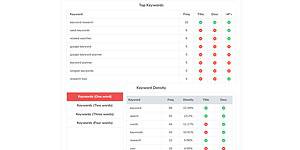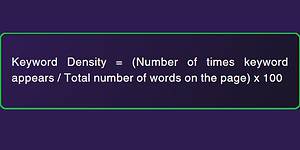Keyword density is a metric in search engine optimization (SEO) that refers to the number of times a target keyword or phrase appears within a given piece of content relative to the total number of words.
Keyword density play important role in search engine opttimization.
We will discuss about what is “Keyword Density” in this page.
What is keyword density?
Keyword density means number of times your keyword appear in web page content.
It helps search engines understand the relevance of a page to a particular query based on the frequency of keywords.

The formula for calculating keyword density is straightforward: divide the number of times a keyword appears by the total number of words on the page, then multiply by 100 to get the percentage.
It's essential to maintain a balance with keyword density. If you are overusing keywords on a web page, then its known as keyword stuffing this can result in penalties from search engines and harm user experience. Conversely, too low a keyword density might not adequately signal the page's relevance to search engines.
While there's no universal optimal keyword density, SEO best practices typically recommend aiming for a keyword density of around 1-3%. However, this can vary based on factors such as web page content length, competitiveness of keywords, and natural language usage.

In modern SEO, the emphasis has shifted towards semantic relevance and user intent. While keyword density remains relevant, it's equally important to prioritize creating high-quality, engaging content that satisfies user queries and provides value.
By understanding the basics of keyword density and its role in SEO, content creators can effectively optimize their content to improve visibility, relevance, and ultimately, rankings in search engine results pages (SERPs).
Importance of keyword desnity in SEO
Keyword density plays a significant role in search engine optimization (SEO) for several reasons:
Relevance:
Search engines use keyword density to understand the topical focus of a webpage. A balanced keyword density indicates the relevance of the content to a particular search query, which can positively impact rankings.
Ranking Signals:
keyword density is still a signal search engines consider when determining a page's rank for specific keywords. Pages with appropriate keyword density may rank higher for relevant searches.
User Intent:
Keywords are a reflection of user intent. By analyzing keyword density, search engines can better match search queries with the most relevant content, improving the overall user experience.
Content Optimization:
Monitoring keyword density helps ensure that content remains focused on the intended topic. It allows content creators to strategically place keywords throughout the content, making it more visible to search engines without resorting to keyword stuffing.
On-Page SEO:
Keyword density is a fundamental aspect of on-page SEO. By optimizing keyword density, businesses can improve the visibility and relevance of their webpages, attracting more organic traffic from search engines.
How to check keyword density?
Checking keyword density is essential for optimizing your content for search engines. Keyword density refers to the percentage of times a keyword or key phrase appears in your content compared to the total number of words.
To check keyword density we can use keyword Density Checker tool also.
Here's how you can check keyword density:
Calculate Total Words: Begin by counting the total number of words in your content. This includes all text, excluding HTML tags and non-text content like images.
Count Keyword Usage: Next, count how many times your target keyword or key phrase appears in the content. Make sure to count each instance, including variations and synonyms.
Calculate Density: Once you have both numbers, divide the total number of keyword occurrences by the total word count, and then multiply by 100 to get the percentage.
Keyword Density Formula
For example, if your content has 500 words and your keyword appears 10 times, the calculation would be:
Keyword Density = (10 / 500) * 100 = 2%
Ideally, keyword density should be kept within a reasonable range, typically between 1% to 3%. However, it's essential to prioritize natural-sounding content over keyword stuffing. Overusing keywords can lead to a poor user experience and may even result in penalties from search engines.
Impact of Keyword Density on Search Engine Rankings
Keyword density is an important on-page SEO element. The number of times a particular keyword appears in the entire content is called keyword density.
What is the effect of keyword density on Google search engine ranking?
According to Google, keyword density should not be more than 1 to 3%. If a keyword is used more often in the content, the keyword density of that content increases; this is also called keyword stuffing. So google can penalize that website. Being penalized by Google can affect the search engine ranking of that website.
Keywords tell Google about the web page or what information is written on that page. Keywords gives information to google about how a web page is related
If the content contains too many keywords, Google will think that the words are being manipulated for search engine ranking.
Maintaining the proper balance of keyword density might help improve your Google search engine ranking.
Using related keywords and synonyms can enhance the meaning of the content without overloading it with a single keyword. This approach helps in improving search engine rankings.
Keyword Density vs. Keyword Stuffing
Keyword density and keyword stuffing are two contrasting concepts in search engine optimization (SEO). Keyword density refers to the percentage of times a target keyword appears in the content compared to the total number of words on the page.
Maintaining an ideal keyword density is essential for SEO as it helps search engines understand the topic and relevance of the content to users' search queries.
Keyword stuffing, on the other hand, involves overloading a webpage with excessive use of a target keyword in an attempt to manipulate search engine rankings.
Keyword stuffing can result in a poor user experience and may lead to penalties from search engines, ultimately harming the website's rankings.
While keyword density aims to strike a balance between using keywords appropriately and providing valuable content to users, keyword stuffing disregards user experience and focuses solely on manipulating search engine algorithms.
How to optimze keyword density
Optimizing keyword density involves strategically incorporating keywords into your content to improve its relevance to search queries while maintaining a natural flow and readability. Here are some steps to optimize keyword density effectively:
Research Keywords:
Conduct keyword research to identify relevant keywords and phrases that your target audience is likely to use when searching for information related to your content.
Determine Ideal Density:
Aim for a keyword density of 1-3%, meaning your target keyword should appear 1-3 times for every 100 words of content.
Use Keywords Naturally:
Include keywords seamlessly into your content, ensuring they fit perfect and enhance the overall meaning of your sentences. Avoid keyword stuffing, as it can negatively impact user experience and SEO.
Distribute Keywords Wisely:
Spread your keywords throughout the content, including in headings, subheadings, meta tags, and body text. This helps search engines understand the topic and relevance of your content.
Utilize Synonyms and Variations:
Use synonyms, related terms, and variations of your target keywords to diversify your content and improve its relevance without overusing the same keyword repeatedly.



